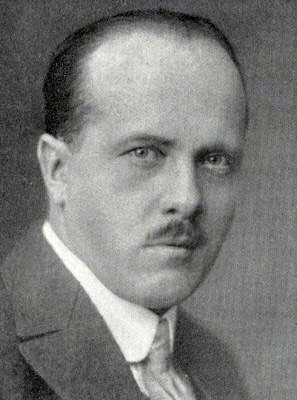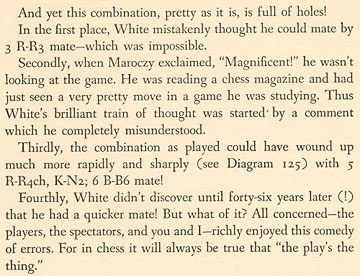Chess Explorations (2) – Solutions to positions 1-4
By Edward Winter

ONE:

White to move. ‘This position is about a century old. Can White
win?’
A number of readers offered such combinative finishes as the following:
- 1 Qxh7+ Kxh7 2 Rh3+ Kg6 3 Ne7 mate;
- 1 Ne7+ Kh8 2 Qxh7+ Kxh7 3 Rh3 mate;
- 1 Nf6+ gxf6 2 gxf6+ Kh8 3 Qxh7+ Kxh7 4 Rh3 mate.
However, all such lines are impossible because of the pin on the a8-h1 diagonal.
Instead, there is the simple win of a piece by 1 Ne7+ Kh8 2 Qxb7, but does
that lead to the simple win of the game? While preparing the prize quiz it occurred
to us that after 2...Qe2 White is hardly home and dry. In view of the complexities,
we submitted the position to Yasser Seirawan, who has kindly commented as follows:
‘It is true that 1 Ne7+ Kh8 2 Qxb7 Qe2 3 Rh3 Rfe8 4 Nf5 Rd3 5 Qg2
Qxg2+ 6 Kxg2 is only marginally better for the first player. A clearer win
occurs after the following: 1 Rh3 Bxd5 2 cxd5 Rfe8 (The best attempt to escape.
If 2...g6 3 Qh4 h5 4 gxh6 Rd6 5 Qe7, with deadly threats.) 3 Rf1 (A very fine
move, as White restrains himself from the greedy pawn grab 3 Qxh7+ Kf8 4 Rf1
Qa2 [If 4...Qd2 5 c4 Qxg5 6 Rh5 with a winning position.] Several entrants
took this line to great lengths, trying to prove that 5 Rxf7+ Kxf7 6 Rf3+
Ke7 7 Qxg7+ Kd6 8 Rf6+ Re6 9 Rxe6+ Kxd5 10 Rxe5+ Kc6 would lead to a win,
but it is hardly clean.) After the text-move, the difference becomes clear.
Black is in a quandary as to how to deal with White’s mating threats.
His tries are:
a) 3 Rf1 g6 4 Qh4 h5 5 gxh6 Rd6 6 Rhf3, winning;
b) 3 Rf1 Qd2 4 Qxh7+ Kf8 5 c4 Qxg5 6 Rh5, transposing into the win given
above;
c) 3 Rf1 Qa2 4 c4 with decisive threats;
d) 3 Rf1 Qb3, which appears to be Black’s best defensive try.
He prevents c3-c4 thanks to the pin against the rook on h3, but now the
difference between the black queen being on a2 and on b3 is laid bare: 4
Qxh7+ Kf8 5 Rxf7+ Kxf7 6 Rf3+ Ke7 7 Qxg7+ Kd6 8 Rf6+ Re6 9 Rxe6+ Kxd5 10
Qxe5+ Kc4 11 Qe2+, the winning check that makes all the difference in the
world. Black is forced to step into a lethal pin, 11...Rd3 12 Rd6, which
forces liquidation into a king and pawn ending. Black is lost.
A much harder problem than anticipated.’
The position was originally discussed in C.N.s 741 and 796 (see page 1 of Kings,
Commoners and Knaves), being taken from an article on chess blindness by
Josef Krejcik on page 14 of the March 1923 Wiener Schachzeitung. Krejcik
stated that the position had occurred in a game played by him, as White, against
a well-known grandmaster in 1907, and he gave more or less the same text on
pages 16-17 of his book 13 Kinder Caïssens (Vienna, 1924).

Josef Krejcik
A complication presented in C.N. 4888 is that on pages 189-191 of How to
Play Chess Like a Champion (New York, 1956) Fred Reinfeld discussed a similar
position:
Reinfeld stated that this position arose in ‘a game played by two Viennese
amateurs many years ago’ and that Maróczy was a spectator. White could
win a pawn with 1 Nxc3 bxc3 2 Qxb7 Rxb7 3 Rxc3 but, Reinfeld said, would have
difficulty in winning and therefore had the idea 1 Ne7+ Kh8 2 Qxh7+ Kxh7 3 Rh3
mate. Then White realized that the rook was pinned, but at this point Maróczy
exclaimed ‘Magnificent’. Consequently, White looked for a finesse
and found 3 d5 Qc8 4 Rd4 g6 5 Bf6 g5 6 Rdd3 g4 7 Rd4 Ne4 8 Rxe4 Qf5 9 Rh3+ gxh3
10 Rh4+ Qh5 11 Rxh5 mate.
Reinfeld then wrote:
In C.N. 4898 Peter Anderberg (Harmstorf, Germany) noted that Reinfeld’s
account was a summary of an article by Krejcik entitled ‘Ein einmaliger
Partieschluß’ on page 179 of the 11/1953 Schach-Echo. Krejcik stated
that he won the game from Jakob Bendiner in March 1907 and that Maróczy’s
comment ‘magnificent!’ (‘prächtig’) was prompted
by a problem of Pauly’s in the Deutsches Wochenschach. Page 212
of the 13/1953 Schach-Echo reported that several readers had noted the
faster mate 5 Rh4+ Kg7 6 Bf6.
It has yet to be explained why Krecjik gave two different positions or why,
on page 14 of the March 1923 Wiener Schachzeitung, he described his opponent
as ‘a well-known grandmaster’.
TWO:

Black to move. ‘The preceding moves were Qg2-b7+ Kg7-h6, followed
by the pawn capture Qb7xb6.’
Thornley v Griffith, London, 1903 was the caption on page 151 of The Basis
of Combination in Chess by J. du Mont (London, 1938). Black unleashed 1…Na4,
described by J. du Mont as ‘a problem move … which is of unusual
beauty’ and ‘a startling and imaginative surprise’. The game
ended 2 Ka2 Nxb6 3 Kxb1 Nd5 4 White resigns.
Almost all entrants gave the correct solution, and many commented on how attractive
1...Na4 is. The importance of the pawn on e6 (preventing 2 Qxf6) is also noteworthy.
The position was discussed in C.N.s 3334 and 3342 (see page 19 of Chess
Facts and Fables). The full game-score has yet to be found.
THREE:

Black to move. ‘The question here is whether the white king
is in, or can be drawn into, a mating net.’
C.N. 1857 (see page 83 of Chess Explorations) gave the game Schönmann
v H. Heinicke, Hamburg, 1952, which culminated in the above position. Black
announced mate in ten moves by 36…h6 37 Ke6 Nc8 38 Rc4 Rb3 39 Bg2 Kg7
40 Be4 Re7+ 41 Kf5 Rf3+ 42 Bxf3 e4 43 Rxe4 Rf7+ 44 Ke6 Kg6, followed by 45…Re7.
As reported in C.N. 2310, in answer to our query at the time about the announcement’s
accuracy, Daren Dillinger suggested 37 Kg6 Rg7+ 38 Kxh6 Kf7 39 f4 Rg6+ 40 Kh5
Rxf4 41 Rb2 ‘with some advantage for White’, and we commented that
consideration doubtless needed to be given to such lines as 39…exf4 40
Bd3 Rb3 41 h4. See pages 29-30 of A Chess Omnibus, which noted that the
mate-in-ten claim appeared incorrect and gave, as an example of the intricate
possibilities, the following analysis by Richard Forster: 36…h6 37 Kg6
Rg7+ 38 Kxh6 Nxd5 39 Rd1 (Black’s win after 39 Bd3 e4 takes longer but
is still assured.) 39…Kf7 40 Bc4 Rg6+ 41 Kh7 Rb8 42 Bxd5+ Kf6 43 Bg8 Rd8
and mates.
And there lay the matter until it was put to readers in the quiz, and a considerable
amount of detailed analysis was received. One entry particularly stood out for
this question, and we quote two excerpts:
‘... I believe Black wins with 1...h6. Black would like to follow
up with 2...Kf7 and 3...Rf4 mate, which leaves White a choice between 2 Kg6
and 2 Ke6.’
As regards the former (more challenging) line, the entrant wrote:
‘2 Kg6 Rg7+ (2...Nxd5 3 Bc4 is unclear) 3 Kxh6 Nxd5 4 Bd3 (4 Bc4
Rxc4 5 Rxc4 Kf7 with unavoidable mate by ...Rg6+, ...Nf6+, ...Rh6.) 4...e4
5 Rd1 Ne7 6 Bc4 Rxc4 7 Rxd6 Rc3 8 Rf6+ Kg8 9 f3 Kh8 10 Kh5 (if 10 Rf7, then
10...Ng8+ 11 Kh5 Rxf7 12 a7 Rxa7 13 Rxa7 Rxf3 14 Kg6 Rxh3 15 Rc7 e3 16 Rxc5
Rh6+ 17 Kxg5 Re6 18 Rc1 Ne7 19 Kf4 Nc6 20 Re1 e2 21 Kf3 Nd4+ 22 Kf2 Kg7 and
Black wins.) 10...Nd5 11 Rh6+ (11 Rg6 will come to essentially the same thing
after 11...Nf4+.) 11...Kg8 12 Rg6 Nf4+ 13 Kxg5 Rxg6+ 14 Kxf4 Rxf3+ 15 Kxe4
Rf8 with a routine if slow win after rounding up the a-pawn.’
In conclusion, no forced mate has been established, but White is ultimately
without any means of escape.
FOUR:

White to move. ‘An odds game gave rise to this position,
with two consultants manning the black forces. How long can they survive?’
This position arose in a queen’s knight odds game won by Samuel Rosenthal
which was published on pages 239-241 of La Stratégie, 15 October 1869.
White announced mate in four moves. In his annotations Rosenthal did not give
the mating line, but it is exceptionally beautiful: 30 Rc5 and if 30…Bc7+
then 31 Rf4.
The game also appeared on pages 66-68 of Gossip’s Vest-Pocket Chess
Manual, which identified the Black allies as ‘the late Duke of Brunswick
and M. Fery d’Escands’. For the mate in four after Black’s
29th move Gossip gave an incorrect move (30 Bd2). 30 Rc5 is the only mate in
four.
For the full score of this remarkable game, see our feature article on Rosenthal’s
exhibitions, A
Forgotten Showman.

Samuel Rosenthal
The solutions to the remaining four positions will be given shortly, together
with the names of the prize-winners.
Submit information
or suggestions on chess explorations
All articles by Edward
Winter
 Edward
Winter is the editor of Chess
Notes, which was founded in January 1982 as "a forum for aficionados
to discuss all matters relating to the Royal Pastime". Since then about
5,600 items have been published, and the series has resulted in four books by
Winter: Chess
Explorations (1996), Kings,
Commoners and Knaves (1999), A
Chess Omnibus (2003) and Chess
Facts and Fables (2006). He is also the author of a monograph
on Capablanca (1989).
Edward
Winter is the editor of Chess
Notes, which was founded in January 1982 as "a forum for aficionados
to discuss all matters relating to the Royal Pastime". Since then about
5,600 items have been published, and the series has resulted in four books by
Winter: Chess
Explorations (1996), Kings,
Commoners and Knaves (1999), A
Chess Omnibus (2003) and Chess
Facts and Fables (2006). He is also the author of a monograph
on Capablanca (1989).
Chess Notes is well known for its historical research, and anyone browsing
in its archives
will find a wealth of unknown games, accounts of historical mysteries, quotes
and quips, and other material of every kind imaginable. Correspondents from
around the world contribute items, and they include not only "ordinary
readers" but also some eminent historians – and, indeed, some eminent
masters. Chess Notes is located at the Chess
History Center. Signed copies of Edward Winter's publications are
currently available.



























 Edward
Winter is the editor of
Edward
Winter is the editor of 




